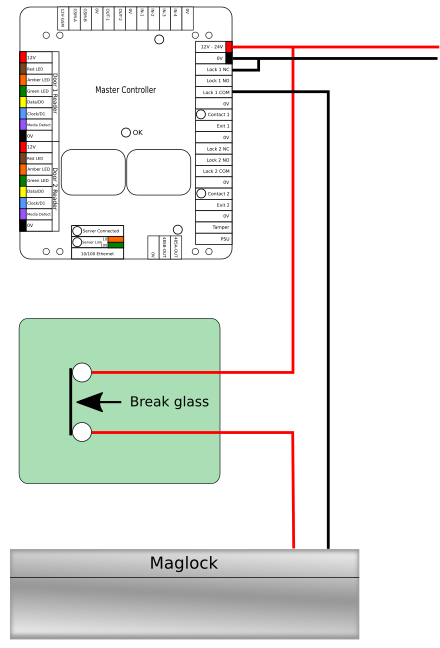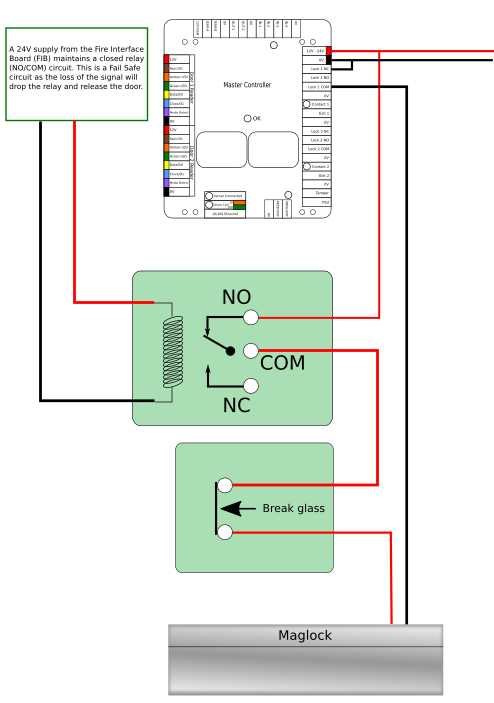Using Access Control with Fire Doors
How to Identify a Fire Escape
Fire doors in common areas should be marked with regulatory signs. These show a white figure running against a green background, often accompanied by the words 'Fire exit' or 'Exit' and a white direction arrow. Where a door is the only way out of a room, it should be treated as an escape route.
Egress Through a Fire Escape Door
A person must be able to open a fire escape door in the event of an emergency. This is normally through a handle which directly opens the lock. In buildings such as theatres where there are large numbers of occupants, the usual method is by using a crash bar which mechanically pulls open the locking bolts. Where access control equipment is fitted to a fire escape door which includes an overriding mechanical release, there are no extra considerations. Where a fire escape door has an electric lock, you must ensure that there is a 'fail safe' way of opening the door in the event of an emergency. Electronic equipment is more vulnerable to fire damage and potential failure, than mechanical locking.
Fail-Safe Opening of Fire Doors
The first step is to use a 'fail open' release for the door. This type of device requires power to lock; it is therefore unlocked when no electricity is supplied. Magnetic locks are normally fail open. The next step is to have a 'fail safe' method of cutting the power to the lock to ensure the lock releases in an emergency. In the event that the access control does not work, there must be an emergency override. In most commercial premises, this is provided by a break glass switch fitted on the 12V lock supply line. Break glass switches are widely available in green and white. Red must not be used as this can be confused with the fire alarm system. In premises where large numbers of people may have to exit at once, doors will almost certainly be released by an interface with the fire alarm system. (FIB. Fire Interface Board). In most cases a local override at each door will also be required. It is possible to link the access control systems to the fire alarm panel. Managed Access Control can send 'Open door' commands to all doors on receipt of the alarm signal. While building owners often specify this, it is NOT a 'fail safe' method of opening the doors as it relies on the access control system being fully functional. A local release method will also be required.
Responsibilities
The installer should be able to discuss these with the client and to provide information on wiring details as necessary. However the end user, or their architect or other consultant, is responsible for defining the fire escape routes and what the requirements of the local fire officer are, as these will vary from authority to authority.
Security Issues
Where doors are released in the event of a fire alarm the security provided by the access control system may be nullified. A break glass unit used in an unauthorised manner will leave the door unlocked. Where high security is required, consideration should be given to using locks, door contacts or break glass units that are linked to a monitoring system. Managed Access Control can provide this facility.
Fail-Open Locks
It is also important that the locks used on a fire exit should not jam under side pressure before the door is unlocked. A person can be pushing on a door in panic while operating the mechanical release or break glass switch causing side pressure on the door. This is particularly likely where a number of people arrive at the door in seconds in an emergency. Many electric motorised bolts, solenoid bolts and some electric releases will jam in this situation. Models are available that have been designed, tested and proven to open in these circumstances. Always get the manufacturer's details regarding this. Maglocks are inherently safe in this regard although be wary of cheap models that can stick over time due to residual magnetism in the armature.
Wiring Break Glass Units and Fire Alarm Interfaces
Where a fire escape door is opened by electronic means, you must ensure that the door can also be opened in case of a failure of the electronic control. The most common method is to fit a break glass switch that breaks the 12V supply cable to the lock. The door may also be released by a fire alarm system. This is most commonly done through a Fire Interface Board, (FIB) provided by the alarm installer. The FIB provides a switching position from where other systems can be controlled by the fire alarm system. A normally open relay, held closed by the fire system will drop in the event of a fire and break the 12V feed to the lock. Where the escape doors are opened by Managed Access Control, a local break glass switch will also be required. The wiring details for these are shown in a later section. Note that local requirements of fire officers vary throughout the country. For example, in some London boroughs a double pole break glass switch is required. This breaks both of the 0V and 12V wires going to the lock.
Wiring a Break Glass
The Exit button must NOT be used to act as an emergency Break Glass. This function relies on a fully working ACU using a 'push to make' circuit. A failure in any part of the circuit due to the fire itself could stop the lock being released and is therefore not 'fail safe' as required. Similarly, a fail secure lock is not permitted, as lock power cannot be guaranteed during all emergencies.
A break glass should be fitted, in conjunction with a fail open release to all fire doors to ensure a reliable egress method in the event of an alarm.

Wiring a Fire Interface Board (FIB) with Break Glass
In the event of a fire, the FIB or Break Glass will override the Managed Access Control ACU by cutting the 12V power to the Lock.
